© ROOT-NATION.com - Use of content is permitted with a backlink.
The new AMD XDNA architecture will allow for the most efficient execution of artificial intelligence algorithms on future Ryzen processors.
Lately, it’s hard not to notice that AMD is pushing XDNA and the renowned NPU microprocessors, which are now inside Ryzen. It’s understandable – the company wants to carve out its place in this niche. After all, AI is now appearing on all devices, including PCs, tablets, and laptops.
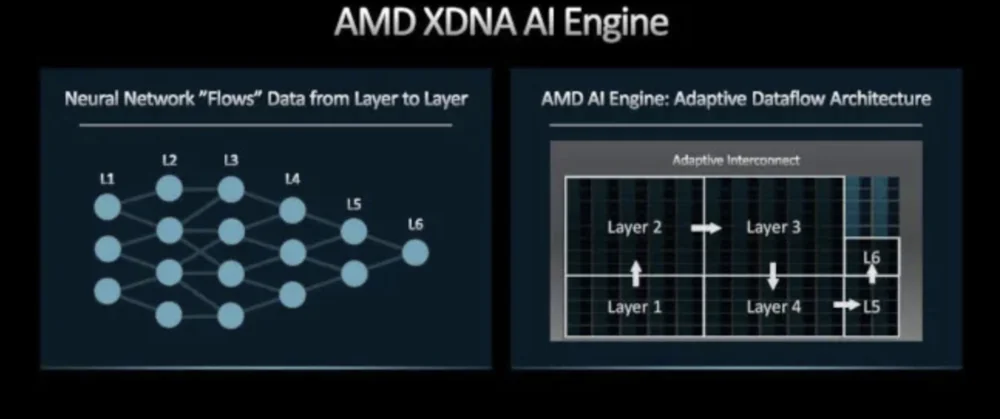
If we already had enough of RDNA and Zen as architectures for processors, then in 2023, another one was born, called XDNA. At AMD, they decided that it was time to start developing a new architecture for graphics processors, central processors, and NPUs, which would efficiently execute artificial intelligence algorithms on future Ryzen processors. In fact, we see that these components will be placed on one chip. Let’s delve into the new XDNA architecture for Ryzen processors from AMD in more detail.
Read also: What is Frutiger Aero and why do modern teenagers feel nostalgic about Windows Vista
What is AMD XDNA?
AMD XDNA is an architecture that supports the NPU processors of AMD Ryzen, whose chip is responsible for specific artificial intelligence tasks. AMD defines it as a “dataflow NPU architecture consisting of a mosaic array of AI mechanisms.” As with Zen or RDNA, there is also development here: we already have the first-generation XDNA, and quite recently, they released an update to the XDNA 2 architecture.

The basis of neural network operation is the flow of data from one layer of neurons to another. Let’s assume there are several layers of neurons, where each “point” performs a computational function – for example, matrix multiplication or convolution, and then the data is passed to the next neuron for processing. There is a significant sequential dependence from level to level. To adhere to this, the Ryzen AI engine architecture operates as an adaptive data flow architecture, where it can effectively utilize a large array of computations and efficiently transmit data from array to array. This can be done without resorting to external memory or even cache, which often consumes more energy and leads to longer delays.

AMD has developed the new XDNA architecture to provide maximum computational density without consuming a large amount of energy and resources. In the XDNA architecture, we see that the IA or AI Engine mechanisms are organized in the form of a mosaic matrix.
The mosaic itself consists of the following elements:
- Vector processor VLIW
- Scalar processor RISC
- Local memory for storing data, activations, and coefficients
- Local data
In ordinary architecture, cache is typically used to fetch repetitive data, but this is not the case with XDNA. In this case, the neural processor NPU uses its own memory and data stream for low-power operation, as accessing the cache increases the processor’s energy consumption.
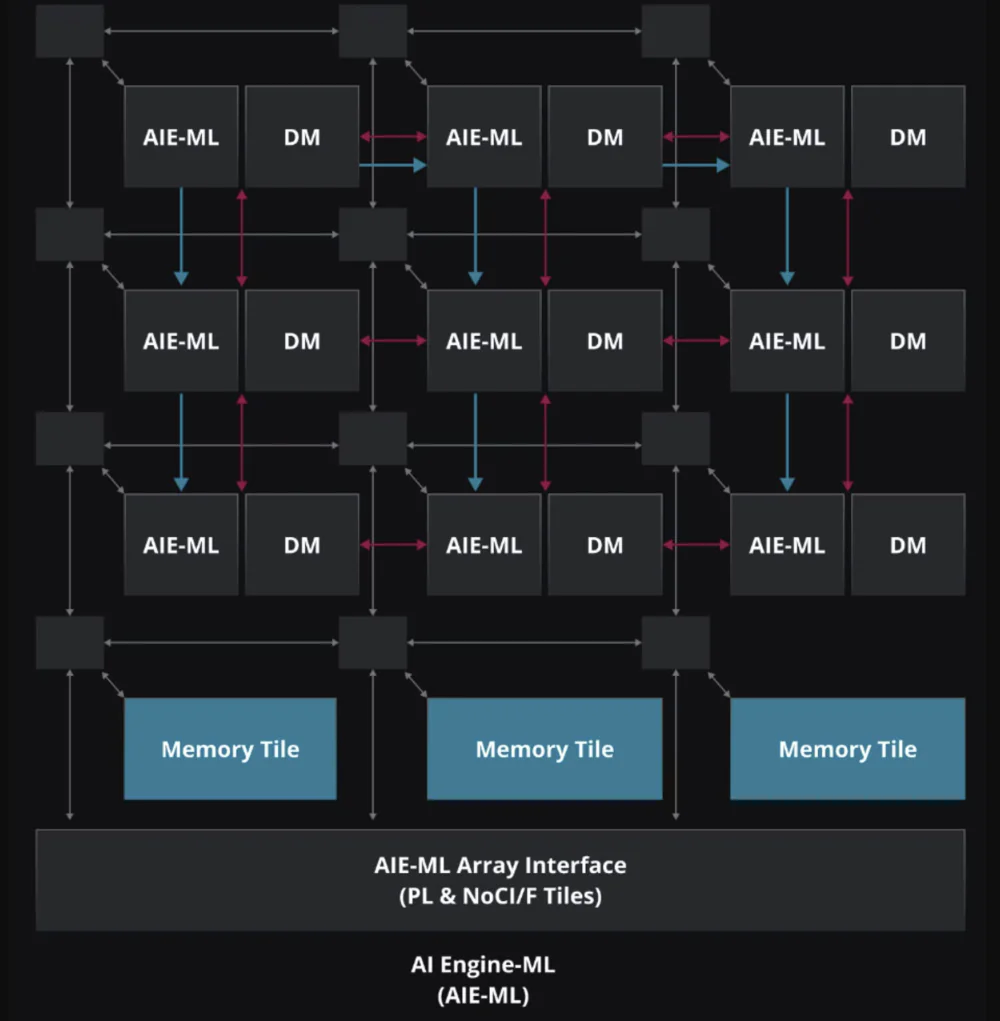
The vector processors we see in each fragment or mosaic are used for machine learning programs and advanced signal processing. They ensure that each artificial intelligence mechanism operates at a frequency of over 1.3 GHz. This is what provides efficient functionality, productivity, and low latency. In simple terms, performance will increase while the energy consumption of the processors remains low.
The scalar processor is a simple class of microprocessors. This processor processes one data element per instruction (typical data elements may be integers or floating-point numbers). In vector processors, unlike scalar ones, one instruction works with multiple data elements. In the new AMD XDNA architecture, the scalar RISC processor will be used for connection modes and data type management.
The debut of the new AMD XDNA architecture has already taken place with the Ryzen 7040, which was introduced in January 2023.
The models in this lineup are manufactured using 4nm FinFET technology, feature up to 8 computational cores with Zen 4 architecture, and have received powerful integrated RDNA3 graphics. Additionally, the AMD Ryzen 7040 became the first processors from the manufacturer with hardware acceleration for algorithms related to artificial intelligence. The AI engine is named Ryzen AI and is based on the scalable XDNA architecture.
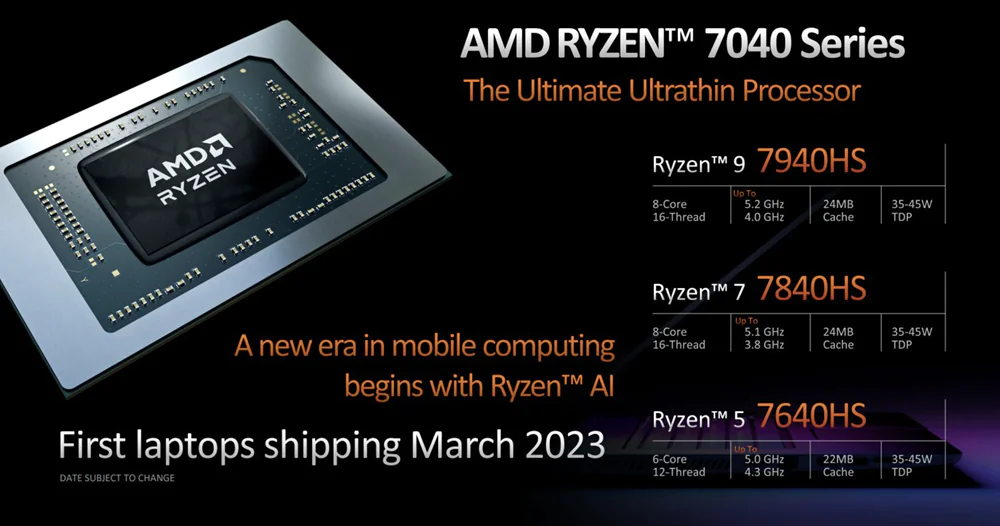
The Phoenix series of mobile chips initially includes three models – the 8-core Ryzen 9 7940HS (8/16; 4.0/5.2 GHz), Ryzen 7 7840HS (8/16; 3.8/5.1 GHz), and the 6-core Ryzen 5 7640HS (6/12; 4.3/5.0 GHz). All chips have a 16 MB L3 cache buffer and L2 cache of 1 MB per core. The specified TDP of all CPUs is configured within the range of 35-54 watts.
Here, the developments of Xilinx, a company acquired by AMD at the beginning of last year for nearly $50 billion, are utilized. Therefore, the integrated Ryzen AI block can be considered the first practical achievement of the strengthened team for consumer solutions.
Read also: Highlights of #MWC2024: Vision of the Future of Electronics World
Advantages of XDNA
Within AMD itself, attention is focused on four advantages of the new XDNA architecture. First and foremost, thanks to the new architecture, the NPU can be programmed and compiled in a matter of minutes. Additionally, this streamlines the workflow for machine learning developers and makes data processing for AI more efficient.
It’s also worth understanding that there is a deterministic advantage, meaning a closer relationship and mutual determinism of all phenomena and processes. Developers say that the Direct Memory Access (DMA) mechanisms themselves allocate data and instruction memory using inter-chip connections. This will allow the processor to work more efficiently.
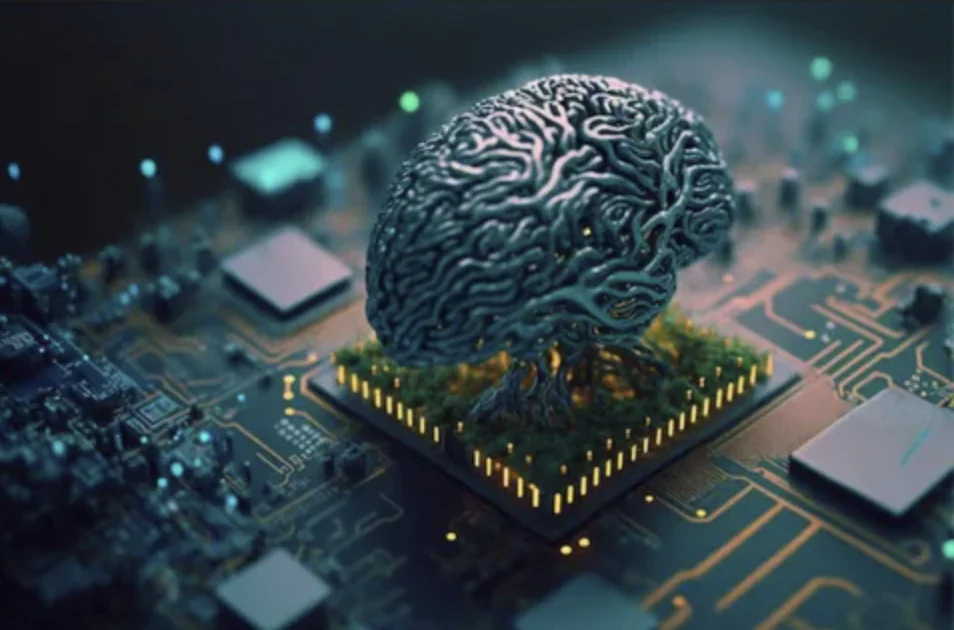
The architecture itself operates more efficiently because the NPU neural processor provides high computational density and excellent energy efficiency. In fact, the presence of the NPU neural processor will be the foundation for the development of the new Windows 12. In other words, AMD is releasing the new architecture for Ryzen processors with future prospects in mind.
The greatest advantage of the new architecture is its scalability. Since 2D matrices consisting of artificial intelligence mechanisms allow scaling from tens to hundreds of tiles on a single device. This is indeed a significant advancement in processor performance.
Read also: Neuralink Telepathy chip: what it is and how it works
But how did AMD manage to realize this in such a short period of time?
The answer to this is quite simple: the acquisition of Xilinx. As a reminder, in February 2022, AMD completed the acquisition of the American company Xilinx for a staggering $50 billion. This is the largest deal in the history of the semiconductor industry. Thanks to this acquisition, AMD expands beyond the scope of its central and graphics processors with a large portfolio of reprogrammable chips.
Essentially, AMD XDNA will be an IP architecture from Xilinx for FPGA structures to accelerate artificial intelligence programs. The technology already existed; AMD simply wanted to implement it in portable processors or mass-market APUs.
AMD is currently only talking about the new Ryzen 8040 with XDNA 3 architecture, as they have not yet been introduced. They have not yet reached the market, and we have not seen tables with different models or options. Furthermore, they are not even advertised on the company’s official website.
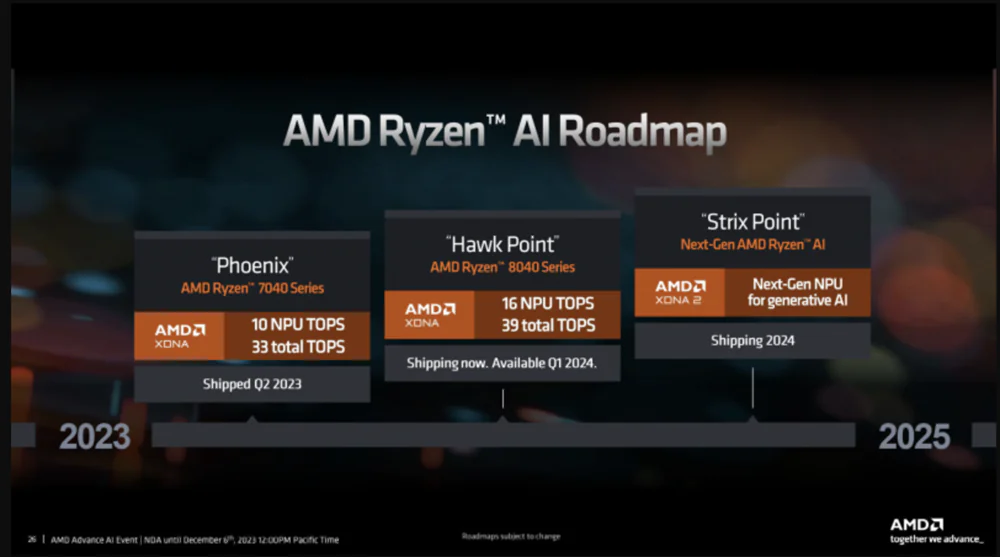
The latest product from AMD on the market is the Ryzen 7040, which features “HS” variants and some exceptions with “HX”. The HS models combine efficiency and performance, and historically, we’ve seen “H” or “HX” for maximum power.
AMD has changed its approach to its lineup of mobile processors, excluding H and HX, and leaving room only for HS and U variants. Furthermore, the brand hardly releases any AMD Ryzen 3 processors; at most, we only see a chip named AMD Ryzen 3 7320U, nothing more!
In terms of technical specifications, the new AMD Ryzen 8040 (Hawk Point) processors are similar to the current Ryzen 7040 (Phoenix) chips. They also feature up to eight Zen 4 cores with support for SMT technology and boost frequencies up to 5.2 GHz. Additionally, they come with a Radeon 740M/760M/780M graphics block based on the RDNA 3 architecture.

According to rumors, the company has prepared three separate lines of Ryzen 8040 processors, differing in terms of TDP levels: Ryzen 8x45HS (35-54W), Ryzen 8x40HS (20-30W), and Ryzen 8x40U (15-30W). Interestingly, the lower-tier models lack an NPU block for AI operations and are likely based on the updated Phoenix2 chip. AMD claims to have improved the NPU block, now providing 40% higher productivity.
Lisa Su, the president of AMD, has promised that the first devices with AMD Ryzen 8040 (Hawk Point) processors will be available for sale by the end of the first quarter of 2024.
Read alsо: How to use Copilot to control your Windows 11 PC
An alternative to AMD XDNA: Low Power Island from Intel
While AMD focuses on its NPU, which integrates all elements, Intel prefers to divide the chip into four parts (graphics, SoC, input-output, and computing). The part that interests us, which can compete with AMD XDNA, is located inside the IO die and is called the Low Power Island.
On the Low Power Island, we find the following:
- Neural processing unit (NPU)
- Memory controller
- Two low-power electron cores
- Infrastructure processor unit (IPU)
- Multimedia engine
- Display engine
- PUNIT microprocessor
- Scaling fabric
Moreover, Intel includes in the SoC mosaic the so-called E-Cores Low Power Island (LP), aimed at energy efficiency. These cores assist the thread director in executing lightweight processes and background tasks.
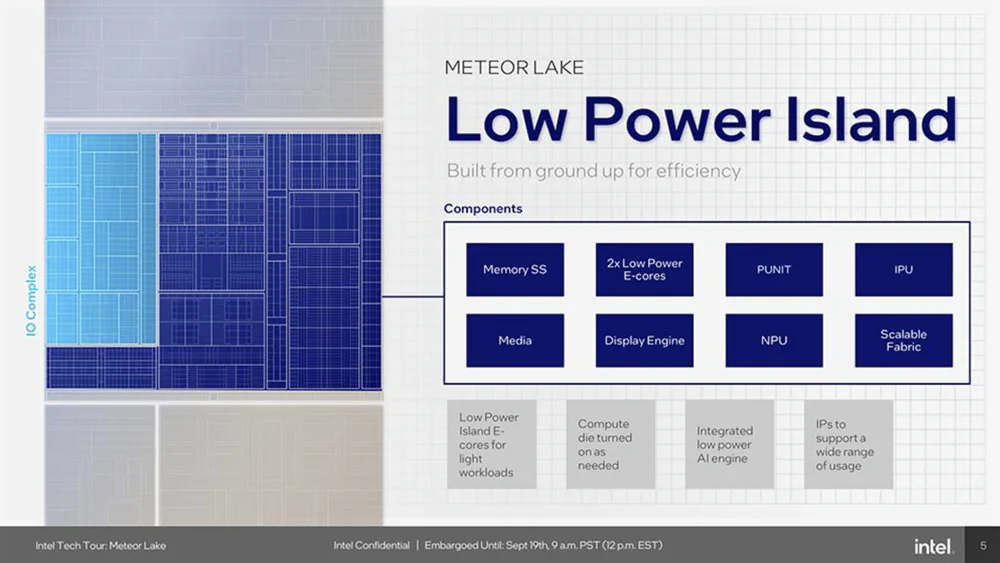
This feature is new for the Intel Core Ultra mobile processors, which were also introduced in December 2023. These chips are already available in stores, and their price is, let’s say, not very budget-friendly. However, it seems like the “AI party” is set to raise the price on chips.
Read alsо: Midjourney V6: all about the next generation of AI
What about AMD XDNA 2?
It’s interesting to note that just 2 months ago, AMD announced XDNA 2. Could you have imagined that Ryzen chips with Zen 5 and Zen 6 would also appear in the same year? Perhaps something similar will happen with AMD Ryzen 8040 and 9040.
In 2024, the AMD Ryzen 8040 has not yet appeared. However, at the same Advancing AI gala event, AMD developers announced the new Strix Point processors based on Zen 5, which will come with the new XDNA 2 architecture. If we haven’t been able to test the AMD Ryzen Hawk Point, imagine what we can tell you about XDNA 2: nothing. Yes, the AMD Ryzen 7040 is equipped with XDNA, but with fewer NPUs than the Ryzen 8040, so we can’t even make any assumptions until the new processors are released.
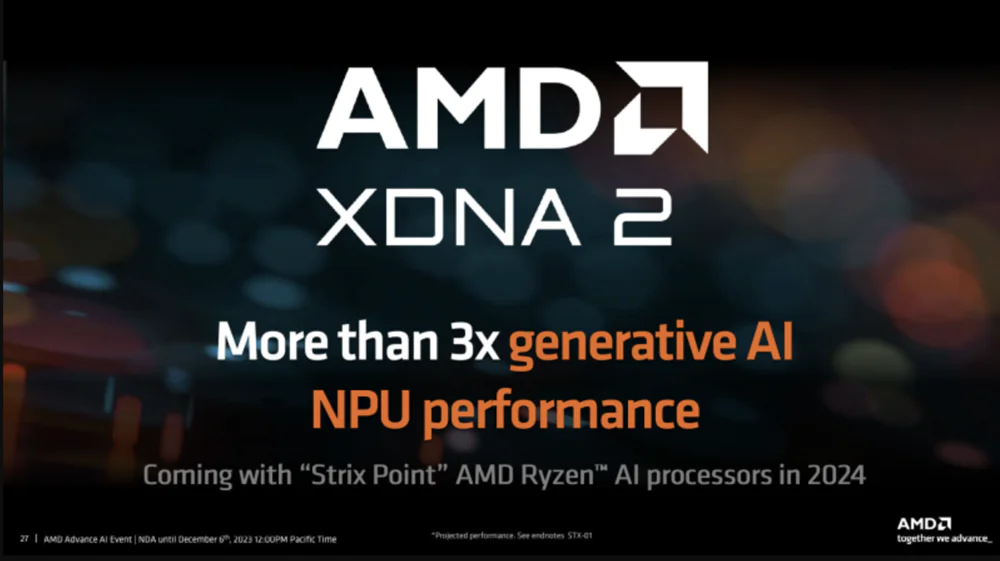
At the presentation, developers claimed that the processor based on the new architecture is three times more powerful than XDNA, but we don’t know how powerful the mentioned NPU architecture is, so we can only take their word for it. I hope AMD isn’t exaggerating the figures for marketing purposes, because they’ve tried to dethrone Intel before, but haven’t come close in this sector. It was a different story on the desktop.
Read also: All About Frontier Supercomputer
Can the new XDNA architecture be used for gaming?
It’s not clear yet, but if they didn’t announce it with great fanfare, it seems we won’t be able to use the new XDNA architecture for gaming. Otherwise, they would have boasted about it immediately, considering AMD’s efforts to conquer the gaming world. Everything seems to be geared towards the business and AI machine learning software, unless the graphics engine doesn’t have artificial intelligence for its operation. The field of application there is very broad in our time.
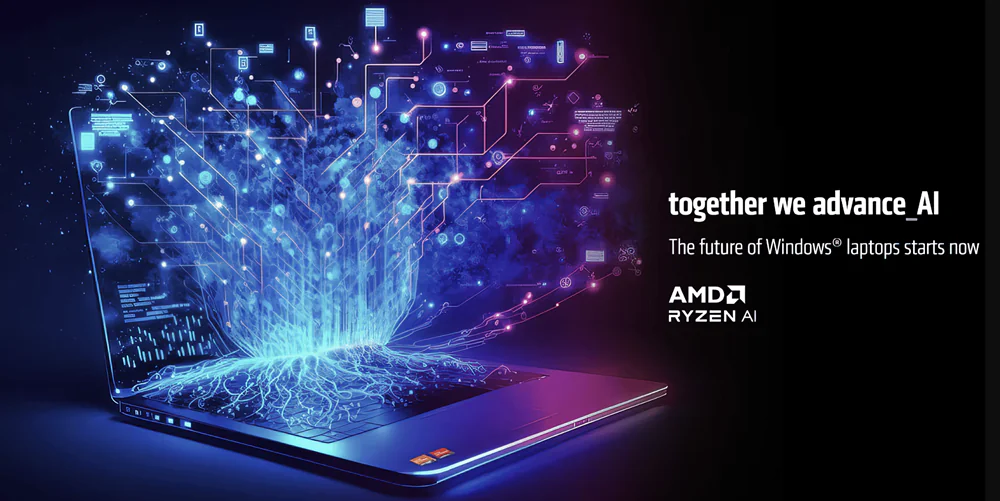
Perhaps, things may change over time. We’ll wait for more details about XDNA and make sure to update you on everything.
Read also:
- Review of Lenovo Legion Glasses: glasses – a pocket monitor for gaming and more
- Samsung Galaxy S24 Ultra Review: Strengths of AI and a Flawed Zoom

